Seeking Sanctuary: Films About Migration
On 7th March, the University of St Andrews will commemorate its second anniversary of its University of Sanctuary status. This is a recognition of its commitment to producing a welcoming environment for scholars and students seeking sanctuary.
The University is also a site of much research and teaching on (forced) migration, including a book co-written by me and my (one-time) colleagues Dina Iordanova and William Brown: Moving People, Moving Images: Cinema and trafficking in the New Europe. At the time, we were intrigued by the ways states and popular films both bolstered and challenged images of Fortress Europe. States might erect and insist on their borders and security measures to protect themselves and their economies from the flows of people, but more often than not, it is those very people whose safety and security are challenged by these borders and the operations of states and corporations).
Films provide an excellent means of turning focus onto those experiencing migration, highlighting the risks and challenges they face. As such they can offer means for producing understanding and empathy of the conditions faced by a growing number of people.
Here are some of them, some available as DVDs in the St Andrews library, and others streaming through various services).
Well-Founded Fear (Shari Robertson and Michael Camerini, 2000)

Well-Founded Fear (Shari Robertson and Michael Camerini, 2000) is an observational documentary that shows the positively exhausting process of asylum through the eyes of those seeking asylum and the multiple government officers in charge of making those decisions. It humanises the process as much as the players, sometimes to gruelling effect, as one realises that the performance of a testimony and the efficacy of a translator can make all the difference.
Barbara Abrash’s case study on the film, which explores the film from inception (the accelerated global movement following the end to the Cold War) to the efforts at impact can be found here: https://cmsimpact.org/resource/well-founded-fear-a-case-study/
The film is available to stream on Vimeo: https://vimeo.com/ondemand/wellfoundedfear
Stranger in Paradise (Guido Hendrikx, 2016)
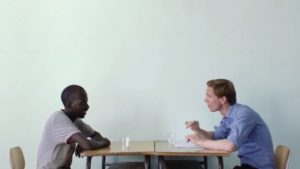
I have been able to teach, although not yet acquire Guido Hendrikx’s Stranger in Paradise (2016). This provocative documentary combines elements of fiction (an actor playing a teacher) with a real scenario: A classroom of asylum seekers who receive three lessons on the European perspective on immigrants: Right, Left, and bureaucratic. The hybrid aspect not only enables exploration into the contradictory messages migrants face, but presents us with that unsettling in-betweenness of this mobility: For all the claims of flow, there is a lot of stasis and confinement.
A version is streaming on Vimeo, but it is not clear whether this has yet been made available to UK audiences (which once again raises questions of how borders can appear in so many places, even those that seem free and open):
https://vimeo.com/ondemand/strangerparadise
Limbo (Ben Sharrock, 2020)
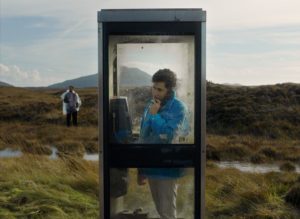
Set and shot on a remote Scottish island, this film (whose title evokes this contradictory space) focusses on 4 refugees awaiting determinations of their status, carrying the past with them and not yet able to move to the future. It is sad and funny, bleak and human, and a film well worth watching.
The film is streaming on Mubi: https://mubi.com/films/limbo-2019-ben-sharrock
Last Resort (Pawel Pawlikowski, 2000)
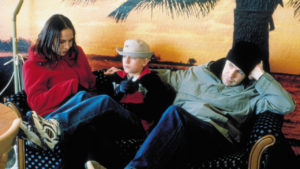
A film with similar themes was released twenty years earlier. Last Resort tells the story of a woman and her son come to London to meet her fiancé. When he does not appear, the woman claims asylum and enters a system that confines them to a seaside resort town (Margate playing a fictional Stonehaven).
People in St Andrews can watch the DVD available at the library, and it is available on multiple streaming sites.
Ghosts (Nick Broomfield, 2006) + some other films about economic migrants
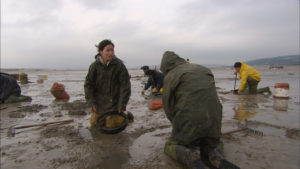
This drama with documentary elements was inspired by the real-life Morecambe Bay disaster, one of the UK’s worst industrial ‘accidents’ in which 23 Chinese cockle-pickers lost their lives. Broomfield opens with the tragedy before flashing back to follow the lives of these undocumented workers, reanimating them and their spirits and exposing the clandestine through cinema. Uniting fiction and documentary— protagonist Ai Qin is played by real-life immigrant Ai Qin, scenes of work are filmed in observational style within the industries—the film animates this space, simultaneously liminal and peripheral, inhabited by so many who travel to the Britain for ostensibly better lives. The attention to the dangers and struggles faced by these migrants, migrants whose labour Europe’s industries depend on, asks us to consider: Who exactly faces the greatest risk and who is deserving of protection and sanctuary?
Ghosts is available in the St Andrews Library although, perhaps fittingly appears restricted to a DVD copy as I’ve not yet found a streaming site.
On a related topic, the documentary The Other Europe (Poul-Erik Heilbuth, 2006), also offering a reenactment of the Morecambe Bay disaster, examines economic, labour, and immigration policy, highlighting Europe’s reliance on undocumented labour and immigration. It is a call to end the hypocritical ‘security’ policies that endanger more people than they protect.
Much like Ghosts, it is available in the St Andrews Library, restricted to a DVD format.
To reassure the reader of the list that there is something that can be watched, I highly recommend Alex Rivera’s short, Why Cybraceros? This 1997 parody of the public information film Why Braceros? which endorsed guest worker policies challenges the logic, highlighting the ways the labour is appreciated but the humans are not. As science fiction (although not really as much as it once was), the film advocates for remotely operated fruit pickers, so one can have all of the work without the foreigners.
https://www.youtube.com/watch?v=Xr1eqKcDZq4
Rivera later expanded on this film, making the brilliant Sleep Dealer (2008).
Bhaji on the Beach (Gurinder Chadha, 1993)
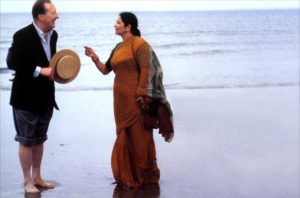
Less about forced or economic migration, and instead exploring the complexities of immigration and movement across space, generation, and culture, Gurinder Chadha’s Bhaji on the Beach offers humour and melodrama on a daytrip to Blackpool.
Here one can see how readily culture can become costume, spectacle, and comfort in ways that allow us to think about the encounters and exchange that occur across all flows. It is an object of its time, to be sure, and I would love to hear of similar films that provide updates for the decades since.
The DVD is available in the St Andrews Library and the film is available to stream in multiple sites including Amazon Prime.
An added interesting viewing available BFIplayer is her short documentary from 1989 called I’m British But…, in which British Asians discuss their experiences and sense of identity.
Paddington (Paul King, 2014)

A list about those seeking sanctuary in the UK would not be complete without a reference to Paddington. Described by a an immigration lawyer as a “walking, talking, ursine pin-up for humanising our work”. Paddington, the creation of author Michael Bond, was born from the phenomenon of child refugees coming to Britain during and post-WWII. This traveller and marmalade loving Peruvian immigrant has been a beloved symbol of Britain, and each film has afforded refugee support organisations the occasion to popularise and gain support for their missions.
The film is streaming on Netflix.
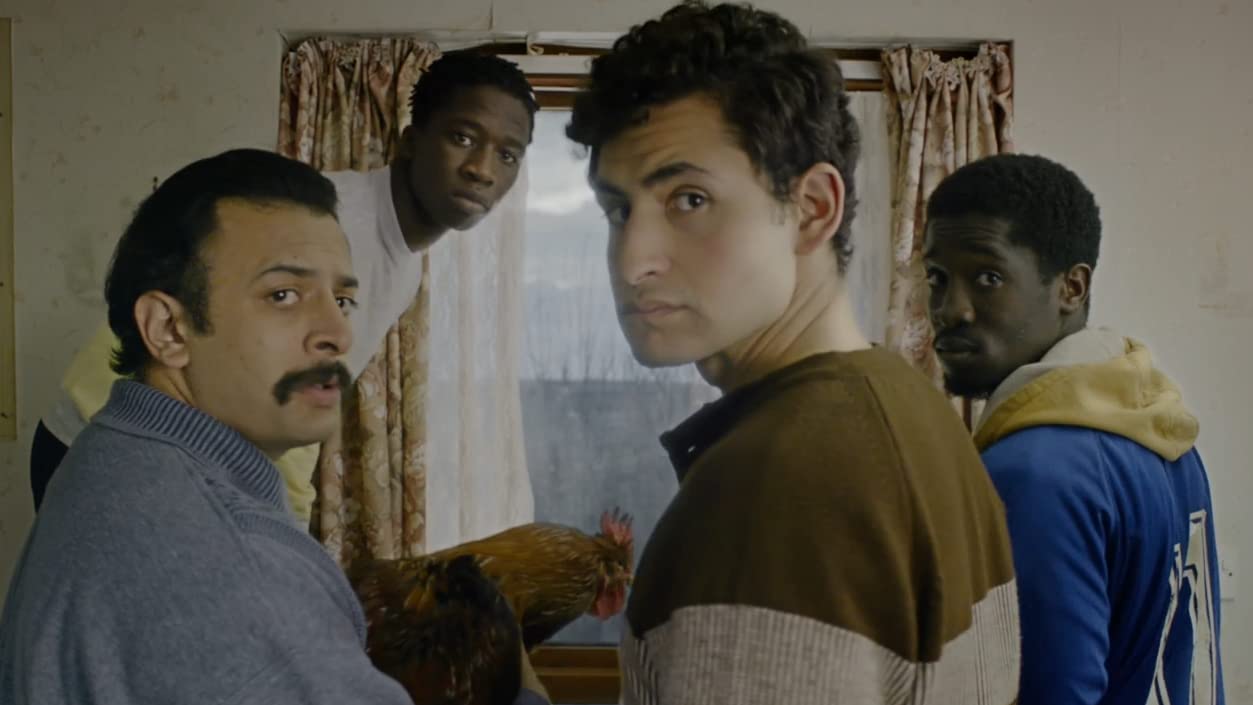
Dheepan (Jacques Audiard, France, 2015) — streaming on Amazon Prime
A great endeavour! This nice list could be, of course, much longer — but there is no need. It is important that many such films continue being made (and many of the European ones are discussed in Temenuga Trifonova’s excellent new book THE FIGURE OF THE MIGRANT IN EUROPEAN CINEMA). I suppose that, once we acknowledged interest in this type of films, each one of us continues monitoring how the discourse evolves — I myself will be discussing a Bulgarian film, FEAR (2020, Ivailo Hristov), for Patty Zimmermann’s film festival at Ithaka at the end of March. This one is about a Bulgarian woman from a small town who gives shelter to a black refugee and then single-handedly takes on his defence against a group of local vigilantes, yet another vignette of the racist environment that Europe represents today.
I agree–that this could be a much longer list! Thank you for your additions– I knew I could count on you for some excellent recommendations.